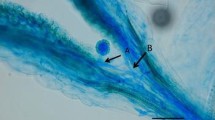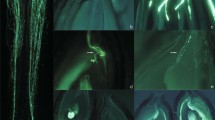Summary
The cross between the rye variety ‘Petkuser Kurzstroh’ and self-fertile plants of the North-American variety ‘Dakold’ was carried out and seed setting of the F 1-generation and of the F 2- and F 3-generation produced by selfing was studied. In most cases seed setting was very high, only a few plants were self sterile, with fertile seeds ranging from 0–5 percent. Differences in the degree of fertility in the group of self-fertile plants are inherited and explained by subvital genes, which are not necessarily connected with the incompatibility system. To get more information on the inheritance of the self-fertility introduced by the variety ‘Dakold’ pollen tube growth after selfing and crossing within the progenies was studied with the help of the petri dish technique. On the basis of the results it is concluded that self-fertility is not caused by an allele of one of the incompatibility loci but by a third factor. Synergic action of this factor with the incompatibility genes and the possible interaction between the alleles of the incompatibility loci of the two different parents are discussed.
Zusammenfassung
Die aus der Kreuzung zwischen der Roggensorte ‘Petkuser Kurzstroh’ und selbstfertilen Pflanzen der amerikanischen Varietät ‘Dakold’ hergestellte F 1-Generation sowie daraus durch Selbstbefruchtung gewonnene F 2 — und F 3-Generationen wurden auf ihre Selbstfertilität untersucht. Vorliegende Untersuchungen ergaben überwiegend fertile Pflanzen mit relativ hohem Samenansatz. Nur vereinzelt traten selbststerile Pflanzen (bis 5% Samenansatz) auf. Unterschiedliche Fertilitätsgrade in der Gruppe der Fertilen sind erblich bedingt. Sie werden durch das Herausspalten fertilitätsvermindernder, subvitaler Gene erklärt, die mit dem Inkompatibilitätsmechanismus nicht in Verbindung zu stehen brauchen.
Um genauere Auskunft über die Vererbung der durch ‘Dakold’ in die Kreuzungsnachkommenschaften hereingebrachten Selbstfertilität zu erhalten, wurde das Pollenschlauchwachstum auf den Narben nach Selbstung und Kreuzung innerhalb der Nachkommenschaften untersucht. Auf Grund der Ergebnisse wird geschlossen, daß die Selbstfertilität nicht durch ein Fertilitätsallel an einem der beiden Inkompatibilitätsloci verursacht wird, sondern ein dritter Faktor für die Selbstfertilität verantwortlich ist. Das Zusammenwirken dieses Faktors mit den Genen an den Inkompatibilitätsloci sowie mögliche Wechselbeziehungen der Inkompatibilitätsallele aus den beiden unterschiedlichen Eltern werden diskutiert.
Similar content being viewed by others
Literatur
Kuckuck, H., und R. Peters: Genetische Untersuchungen über die Selbstfertilität bei Secale vavilovii Grossh. und Secale cereale L. var. Dakold im Hinblick auf Probleme der Züchtung und Phylogenie. Z. Pflanzenzüchtg. 57, 167–188 (1967).
Lundqvist, A.: Self-incompatibility in rye. I. Genetic control in the diploid. Hereditas 42, 293–348 (1956).
Lundqvist, A.: A rapid method for the analysis of incompatibilities in grasses. Hereditas 47, 705–707 (1961).
Lundqvist, A.: The nature of the two-loci incompatibility system in grasses. I. The hypothesis of a duplicative origin. Hereditas 48, 153–168 (1962).
Lundqvist, A.: The mode of origin of self-fertility in grasses. Hereditas 59, 413–426 (1968).
Lundqvist, A.: Self-incompatibility in Dactylis glomerata L. Hereditas 61, 353–360 (1969).
Lundqvist, A.: Some effects of continued inbreeding in an autotetraploid highbred strain of rye. Hereditas 61, 361–399 (1969).
Müntzing, A., and S. Akdik: Cytological disturbances in the first inbred generations of rye. Hereditas 34, 485–509 (1948).
Author information
Authors and Affiliations
Additional information
Angenommen durch W. Seyffert
Frau E. Szemes und Fräulein B. Gathmann gilt mein Dank für ihre Hilfe bei der Durchführung der Versuche.
Für die Unterstützung dieser Arbeit danke ich der Deutschen Forschungsgemeinschaft.
Rights and permissions
About this article
Cite this article
Wricke, G. Untersuchungen zur Vererbung der Selbstfertilität beim Roggen (Secale cereale). Theoret. Appl. Genetics 39, 371–378 (1969). https://doi.org/10.1007/BF00290876
Received:
Issue Date:
DOI: https://doi.org/10.1007/BF00290876




